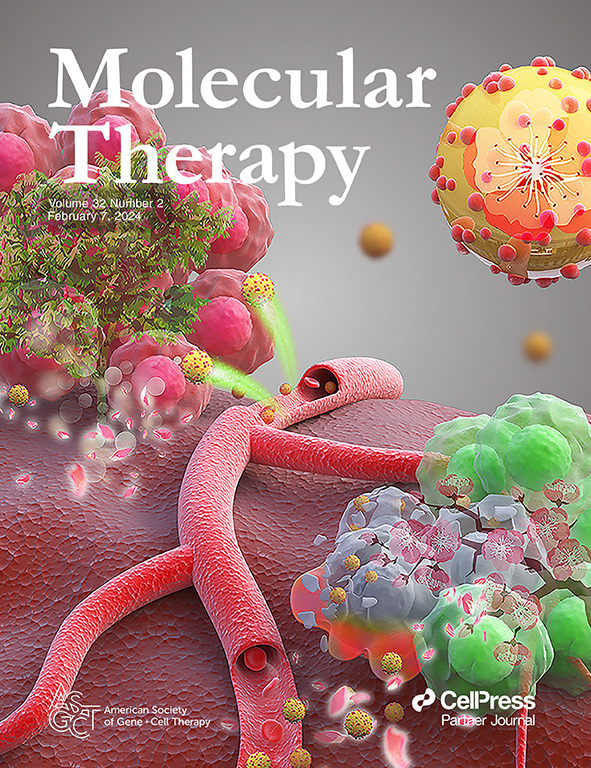外源性VWF前肽补充对2A/ⅡC型血管性血友病血管性血友病因子多聚合的纠正作用
IF 12
1区 医学
Q1 BIOTECHNOLOGY & APPLIED MICROBIOLOGY
引用次数: 0
摘要
基因治疗仍然是治疗血管性血友病(VWD)的唯一方法,但受血管性血友病因子(VWF)基因大小的限制。影响VWF前肽(VWFpp)的变异损害多聚,导致2A/IIC型VWD。VWFpp作为VWF多聚体组装的ph敏感模板,表明在反式中补充VWFpp可以恢复具有缺陷前肽的VWF变体的多聚体。野生型VWFpp与突变型全长VWF在体外的共表达导致了8种2A/IIC型VWF引起变异的VWF多时间谱的适度但一致的改善。值得注意的是,D2:D2界面有缺陷的变异对VWFpp的要求较低,而D2:D2界面完好的变异对VWFpp的要求较高。此外,在内皮特异性启动子的控制下,用编码VWFpp的AAV9载体处理携带p.Tyr87Ser突变的2A/IIC型VWD转基因小鼠模型。VWFpp可显著恢复VWF多聚性,使VWF:CB水平从15.8±10.2%提高至71.2±12.7%,持续至少16周,纠正出血倾向,改善血小板功能。体外和体内研究结果表明,在反式VWFpp中补充VWFpp可以纠正由VWFpp变异引起的VWF多聚缺陷,为2A/IIC型VWD提供了一种新的治疗策略。本文章由计算机程序翻译,如有差异,请以英文原文为准。
Correction of von Willebrand factor multimerization in type 2A/ⅡC von Willebrand disease by exogenous VWF propeptide supplementation.
Gene therapy remains the only cure for von Willebrand disease (VWD), but is limited by the large von Willebrand factor (VWF) gene size. Variants affecting the VWF propeptide (VWFpp) impair multimerization, causing type 2A/IIC VWD. VWFpp serves as a pH-sensitive template for VWF multimer assembly, suggesting that in trans VWFpp supplementation may restore multimerization in VWF variants with defective propeptides. Co-expression of wild-type VWFpp with mutant full-length VWF in vitro led to modest yet consistent improvements in the VWF multimer profile across eight type 2A/IIC VWD-causing variants. Notably, variants with defect D2:D2 interface required lower levels of VWFpp for multimerization rescue, whereas those with intact D2:D2 interfaces exhibited a greater demand. Futhermore a transgenic mouse model of type 2A/IIC VWD carrying the p.Tyr87Ser mutation was treated with an AAV9 vector encoding VWFpp under the control of endothelial-specific promoters. VWFpp administration remarkably restored VWF multimerization, increased the VWF:CB levels from 15.8±10.2% to 71.2±12.7% for at least 16 weeks, corrected the bleeding tendency and improved platelet function. Both in vitro and in vivo findings demonstrate that in trans VWFpp supplementation can rectify defects in VWF multimerization caused by variants in VWFpp, offering a novel therapeutic strategy for type 2A/IIC VWD.
求助全文
通过发布文献求助,成功后即可免费获取论文全文。
去求助
来源期刊

Molecular Therapy
医学-生物工程与应用微生物
CiteScore
19.20
自引率
3.20%
发文量
357
审稿时长
3 months
期刊介绍:
Molecular Therapy is the leading journal for research in gene transfer, vector development, stem cell manipulation, and therapeutic interventions. It covers a broad spectrum of topics including genetic and acquired disease correction, vaccine development, pre-clinical validation, safety/efficacy studies, and clinical trials. With a focus on advancing genetics, medicine, and biotechnology, Molecular Therapy publishes peer-reviewed research, reviews, and commentaries to showcase the latest advancements in the field. With an impressive impact factor of 12.4 in 2022, it continues to attract top-tier contributions.
 求助内容:
求助内容: 应助结果提醒方式:
应助结果提醒方式:


